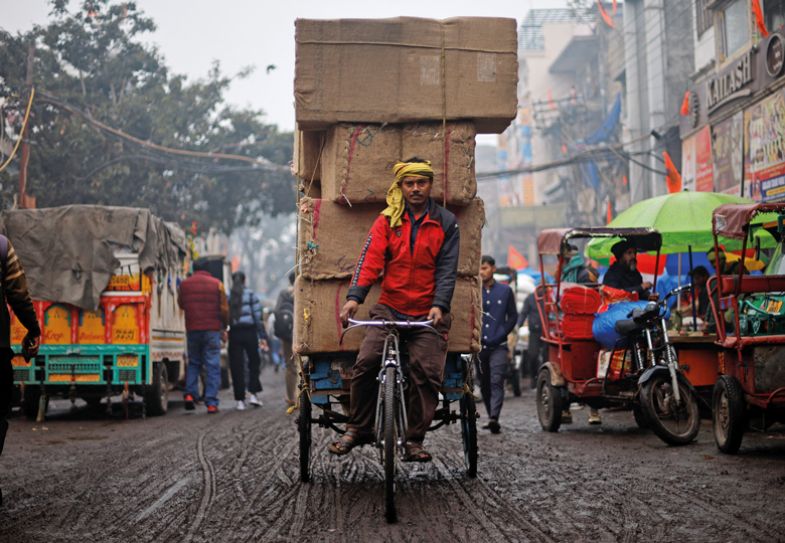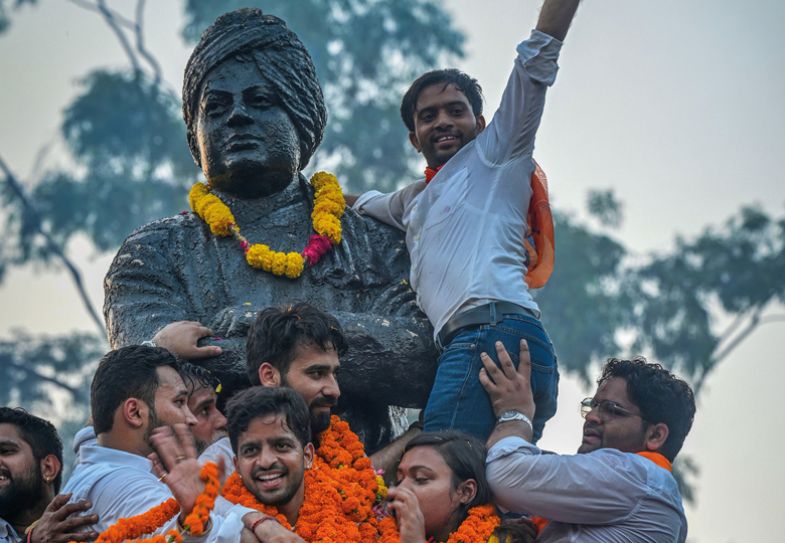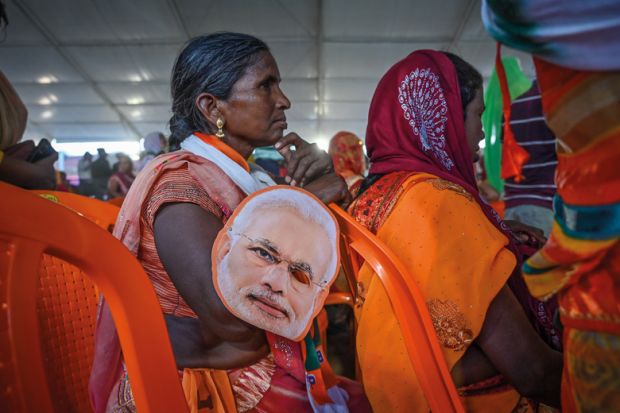On the day the National Education Policy (NEP) was finally approved by India’s Cabinet, most Indians had bigger things on their minds. It was 29 July 2020, and the number of coronavirus cases globally had reached nearly 17 million, with almost 1.5 million of those in India. The country’s campuses were closed, and the virus was surging through the slums of Mumbai, while monsoon rains battered the state of Bihar, forcing many to abandon their homes.
Yet the NEP’s potential to initiate a monumental shift in the purpose, operation and clientele of Indian universities had already been recognised by those who had read the draft policy, which had been published for consultation the previous year, before Covid’s ravages and shortly after Narendra Modi was re-elected for his second five-year term as prime minister.
The policy was the first major reform of education policy in the world’s most populous country since 1986 and was suitably comprehensive, promising to transform the entire system by 2030. A new impetus was certainly long overdue in Indian higher education, which is widely seen as underperforming internationally, with not a single university among the top 200 of Times Higher Education’s World University Rankings and a long tail of low-quality institutions.
The remedies offered by the NEP were forward-thinking: massively increasing enrolment, establishing an Academic Bank of Credits (ABC) so all citizens could have a digital wallet of credentials, positioning India as a global study destination and allowing international institutions to operate within India, broadening the country’s traditionally technically focused curricula, and expanding open and distance learning.
“It’s a complete rejig of the system,” says Aarti Srivastava, head of the higher and professional education department at the National Institute of Educational Planning and Administration (NIEPA).
About six weeks after the plan’s enactment – when gyms began to reopen and weddings were again permitted, while universities remained firmly shut – Modi declared in a video call to a nation desperate for causes for optimism that the NEP would “give new direction to 21st-century India” and “sow the seeds for starting a new era”.
Implementation of the policy has been politically fraught, however. And with high levels of graduate unemployment driving increasing disillusion with higher education, hesitancy among top global institutions to accept the invitation to operate in India, and growing exasperation at political interference in universities, transforming the system looked a tall order even before Modi’s unexpectedly poor showing in this month’s general election, which wiped out his Bharatiya Janata Party’s overall majority. Now, observers are questioning whether Modi’s seeds for the new era might ever fully germinate.
The NEP 2020 had been in the works for several years, with policymakers, educators and the general public all participating in a lengthy consultation process. With time running out to capitalise economically on India’s massive youth population bulge, policymakers prioritised ensuring access to education. Accordingly, the NEP sets out a target of having “at least one large multidisciplinary [higher education institution] in or near” each of India’s 766 districts, with an aim of almost doubling the gross enrolment ratio (GER) in higher education, including vocational education, from the 26.3 per cent it was in 2018 to 50 per cent by 2035.

By 2021-22, the GER had crept up to 28.4 per cent, and the target will be “easily met”, believes Furqan Qamar, professor at Jamia Millia Islamia’s Centre for Management Studies and former secretary general of the Association of Indian Universities. The greater issue, he argues, is what will happen to students once they graduate, with high youth employment being among the reasons suggested for the BJP’s failure to win another overall electoral majority.
“The biggest challenge that the government is faced with is unemployment and underemployment among the graduates,” agrees Saumen Chattopadhyay, associate professor of education at Delhi’s Jawaharlal Nehru University (JNU). “Increasing numbers of youths are entered in the labour force, but, commensurately, job opportunities are not being created,” he says.
In 2022, the International Labour Organization found that India’s graduates were nine times more likely to be unemployed than Indians with no schooling at all, only 3.4 per cent of whom are without work. And underemployment is a pervasive issue, with university-educated rickshaw drivers and farm workers commonplace.
Of course, graduate unemployment is a problem in many countries. In 2023, the Chinese government made headlines when it appeared to address plummeting youth employment rates by declining to publish the data altogether. However, the problem in India is exacerbated by the vast size of its youth population (249 million Indians are aged between 20 and 29, compared with 168 million Chinese, the latest World Bank data indicates).
“The number of [Indian] youths who are looking for a job is significantly higher than all the countries of the world. And the problem is all the more severe because the quality of higher education…and secondary school education [in India] is not that good,” Chattopadhyay says. “When [students are] entering the job market, industry people typically say, ‘You’re not employable.’”
Modi’s government is attempting to tackle this skills deficit via the Academic Bank of Credits, which aims to encourage lifelong learning and retraining and emphasises a shift towards vocational education. “The government is trying to empower the students by giving them the freedom to choose courses so that they can be job-ready,” says Chattopadhyay.
This pivot, however, is not popular with everyone. Some academics suspect it is part of a wider plan to downgrade the status of universities – particularly public universities, which the BJP sees as a check on the advance of its Hindu-nationalist (Hindutva) ideology.
“Given the larger political agenda of the RSS [an umbrella body encompassing the BJP that promotes Hindutva], they do not see their politics in alignment with the public universities, because a lot of these public universities follow the affirmative action programme whereby students from lower echelons of society make it to higher education,” says Ajay Gudavarthy, an associate professor of political studies at JNU. “And RSS’ own understanding is that people who come from these backgrounds through higher education institutions don’t align with their politics. So it’s also their [the RSS’] agenda to privatise and close down and run down public universities as much as possible.”
In 2021-22, when the most recent All India Survey on Higher Education was carried out, private universities accounted for 41 per cent of India’s 1,168 universities, educating 26.7 per cent of students. Private universities have been proliferating under the BJP government, with 140 new institutions established in the past five years, according to the Ministry of Education. While many observers welcome this shift, arguing that there simply is not enough money or capacity to cater for student demand without this expansion, some critics decry what they see as the purposeful erosion of public education.

The sense that the BJP – in common with other right-wing populist parties around the world – sees universities as cultural opponents is supported by the political interference and curbs on academic freedom that have been experienced under the Modi administration.
Professors critical of the government report being detained at the Indian border, having their overseas citizenship status cancelled and being threatened and intimidated online.
BJP-supporting students have also played a part in bearing down on free speech, targeting anyone deemed to be critical of the government. As early as 2016, two years into Modi’s prime ministership, the student wing of the BJP at the Central University of Haryana at Mahendragarh tried to bring a case of sedition against fellow students and teachers involved in the staging of an award-winning play that they regarded as portraying the Indian army in an unflattering light, for instance.
“There is a huge vigilantism that has been set up,” says a representative of the India Academic Freedom Network, who prefers not to be named. “Young people, even students in colleges…feel entitled, if they support the right-wing government, [to] just snoop on anyone [and] stop any lecture” if they disagree with the lecturer. “Any good speaker, who’s known to…speak freely and question government policies or support ideas of democracy [will have their] lecture cancelled.”
In some cases, simmering tensions on campus have escalated into all-out violence. In 2020, a mob of people in masks entered the campus of JNU – known for its progressive political stance – and attacked students. Some accused the BJP’s student wing of instigating the violence and said the police had been slow to act, while others blamed left-wing activists. It followed an incident the previous year in which police forcefully entered Delhi’s Jamia Millia Islamia and aggressively suppressed student protests. Subsequently, academics reported an uneasy atmosphere on campuses, with many choosing to refrain from publicly criticising the government for fear of repercussions.
Nor is it only public universities that have come under the BJP’s spotlight. Delhi’s Ashoka University, one of several wealthy new private universities that have been established in recent years by philanthropists and industrialists, has apparently felt the need to take action on several occasions to avoid getting on the wrong side of the party. In 2021, a public intellectual and prominent critic of the BJP, Pratap Bhanu Mehta, resigned as professor of political science, citing his fears that his “association with the university may be considered a political liability”. And last year, an economist, Sabyasachi Das, left his position after publishing a paper that suggested that the BJP may have manipulated the results of the 2019 general election; the university had earlier distanced itself from the paper despite not having carried out an academic review of the research.
Modi’s government has also been widely accused of installing university leaders who are sympathetic or even aligned to the BJP. These claims were repeated by the opposition leader, Rahul Gandhi, in this year’s election race, prompting numerous vice-chancellors to respond with an outraged open letter asserting that their appointments were based on merit.
But scepticism persists. “There is no doubt that merit has been compromised in India,” says Deepti Acharya, an assistant professor of political science at the Maharaja Sayajirao University of Baroda. “The preference is not being given to those who are really capable.”
The BJP has wielded influence through states' centrally appointed governors, using them “as a tool to interfere in the day-to-day affairs of the university, especially in the appointment of vice-chancellors and nomination of members to university bodies like the senate and syndicate [executive council]”, says Eldho Mathews, programme officer for the internationalisation of higher education at the Kerala State Higher Education Council. But governments in opposition-run states, including Kerala, have fought back, attempting to pass bills that reduce the power of governors over universities. The result has been something of a political tug of war between the central and state governments for control of higher education in these regions.
There is nothing new about political interference on Indian campuses. If Modi had lost the election, Acharya argues, the new government would have exerted similar strategies for control over Indian universities “because it’s a game of revenge. Universities are inseparable from politics,” she says. “Political parties are very deeply interested in Indian campuses and what is happening over there. India has not realised so far, even after 75 years of independence, that education is not part of politics.”
Nevertheless, the India Academic Freedom Network representative says political intimidation “sharply came into focus” during Modi’s second term, when the BJP ruled with an increased overall majority in the Indian parliament and its hegemony was regarded as virtually unassailable.
The shattering of that veneer by this month’s election result and the unexpectedly strong showing by the Congress-led opposition alliance has prompted widespread hopes, by contrast, that the worst of the BJP’s attempts to impose its authority on universities may be over for now.
“India has got good opposition. That is a safe point for Indian universities because the freedom of speech can be maintained only when there is a strong opposition,” says Acharya – although she is unsure how long the opposition alliance will endure.
But nor are the BJP’s coalition partners necessarily unshakeable, and, for them, as small regional parties, “higher education reforms at the national level are not a policy priority”, Mathews says. Hence, “to avoid controversies in its relationship with the partners, the BJP will not try to advance its political agenda through the higher education sector”, he predicts. “The interference of governors in state universities may not continue as the BJP will be cautious.”
India’s minor political earthquake may also have implications for the NEP, which is not without its Hindutva elements. Initially, says Saikat Majumdar, professor of English and creative writing at Ashoka (speaking in a personal capacity), “it was heartening to see the [NEP] committee’s commitment to [liberal arts] education, which felt like a welcome turn away from the traditional colonial-bureaucratic focus on the single-subject, examination-driven system. But other worrying factors soon made their appearance – among them, the presentation of the country’s culture and past in solely Hindu-Brahminical terms, to the exclusion of all other traditions that make this rich and diverse nation, and the strategic shaping of educational curricula according to this need.”
Justifying the proposed shift to multidisciplinary education at universities, the NEP references traditional teaching styles at “ancient” Indian universities. It declares: “India urgently needs to bring back this great Indian tradition to create well-rounded and innovative individuals, and which is already transforming other countries educationally and economically.”
That passage illustrates the tensions inherent in the BJP’s aspiration to push for a renewed focus on Hindu-based knowledge (which critics describe as the “saffronisation” of education) while simultaneously striving for greater international status by introducing policies that mirror Western education systems, including increased privatisation and internationalisation.
“Society is highly confused about this system. [The West] is also confused about this system,” says Acharya. “What is happening, nobody knows. On one [hand], you are talking about Hindu philosophy; on another, you are adopting approaches which are completely westernised.”
Accordingly, the NEP’s ambitions to attract more international students to India, to encourage partnerships with “high-quality” foreign institutions, and to allow top-ranked foreign universities to operate in India have so far had mixed success. For instance, while many partnerships have been established – one example being the joint master’s in data science and AI offered by the University of Birmingham and the Indian Institute of Technology Madras – Western partners often report a lack of follow-through from the Indian side. This stems in part from Indian inexperience in international partnerships, but it’s also down to funding, explains Chattopadhyay. “The challenge is that we don’t have funds to send our faculty and students to study and do research [abroad],” he says. “Therefore, there are many agreements which have [been] reached but they do not materialise meaningfully.”
And while some Western universities initially expressed an interest in establishing branch campuses in India, the response has been muted since the associated regulations were published late last year. Those regulations offer two options. Overseas universities can set up a campus anywhere in India, but that requires them to negotiate a complex regulatory environment and, potentially, submit to a high tax burden. Alternatively, they can set up in GIFT City, a regulation-light zone under construction in Gujarat, Modi’s home state. However, that is relatively far from key hubs and student bases.
Two Australian universities – Deakin and Wollongong – have established teaching spaces in GIFT City, and it has been hinted that more may be coming. Beyond this, however, “the best [universities] have not shown any keenness to come to India despite the regulatory framework”, says Jamia Millia Islamia’s Qamar.
Analysts believe Modi needs to do more if he truly wants to transform India into a hub for international universities. Qamar argues that, in general, top institutions have been enticed to set up branches abroad only if they are offered help to obtain land for a campus and significant subsidies; Qatar, for instance, spends more than £280 million each year hosting branch campuses of six US universities at its 20-year-old Education City campus – one of which, Texas A&M University, announced earlier this year that it would nevertheless be closing because of “instability” in the region.
There is “a big question mark” about whether Modi would offer such inducements when domestic institutions are so underfunded, Qamar says. “There would be some kind of resentment that you are not funding your own institution, and [Indian universities] would see it as a conspiracy to undermine [them].”
If branch campuses are not established in significant numbers, vast numbers of Indians will continue to pursue their higher education abroad. Currently, more than 1 million are estimated to do so, amounting to a huge economic drain for their home nation.
“India is a net importer of higher education,” says Qamar. “That is a situation that any government would want to correct.” But while India is trying to attract foreign students to its own institutions, the number entering does not come close to balancing the outbound figures.
“The only way to actually address that is to create your own strength,” says NIEPA’s Srivastava. “We should build an institution which can be on par with Oxford, so quality will be the magnet to attract people.” Although the Indian government has established an excellence initiative, known as “institutes of eminence”, the funding “is not sufficient” to elevate selected institutions to the status of world-class universities, she argues. Indeed, the programme has struggled even to recruit enough suitable institutions, with only 12 out of a targeted 20 (10 each from the public and private sectors) so far enrolled.
Modi “needs to spend heavily on the university system and on research”, says Srivastava. “He needs to understand that the road to development is through higher education.” So far during the Modi era, she says, funding has failed to keep pace with expanding university populations, and there have been cuts to the University Grants Commission (UGC), which distributes funds to central and state universities, and even to the elite Indian Institutes of Technology and Indian Institutes of Management networks.
“Many labs are running dry and many programmes cannot do much because the funding has been over a period of time receding,” Srivastava says.
Total education spending in 2022 amounted to just 2 per cent of India’s gross domestic product – significantly lower than the 6 per cent target set out in the NEP. That elusive figure has been repeatedly floated by policymakers since the 1960s, says Qamar, “so it was not a surprise that it was repeated in the National Education Policy”. However, “three budgets down the line [since the NEP was published], we don’t see any movement in enhancing allocations for education”.
Nor is the funding situation expected to change during Modi’s third term. The BJP’s manifesto was vague about higher education, promising merely to “upgrade” institutions through “focused” funding, as opposed to offering an increase. Most academics expected Modi to largely maintain the status quo, keeping funding stable (albeit at a lower level than universities would like) while pressing on with implementing the NEP.
But that was far from plain sailing even before Modi was revealed to be politically mortal after all, with several opposition-controlled states pushing back against NEP implementation. For instance, Congress-governed Karnataka announced last year that it was withdrawing from the NEP and implementing instead a Karnataka Education Policy from the coming academic year. Tamil Nadu, too, has rejected the NEP outright, seeing the schools part of it as a ploy to impose the Hindi language on the region – although the region’s announcement of a common curriculum for higher education institutions last year caused huge controversy before the ministry backed down.
Other opposition-led governments, such as those in Kerala and West Bengal, also oppose the NEP but have adopted its requirement for all undergraduate degrees to be four years in duration.
“Why they are doing it?” asks the JNU’s Chattopadhyay. “Because the students have been given this Academic Bank of Credits enrolment number. If I do not implement the Academic Bank of Credits in my university, in my state, hypothetically speaking, my students, will suffer. If their degrees are declared to be invalid or [students] can’t exercise mobility, who suffers? Students suffer,” he says, referring to fears that students whose degrees are not nationally recognised might be unable to pursue postgraduate study elsewhere in India, for instance.
“You can’t argue, ‘Let the students suffer: my politics comes first,’” Chattopadhyay says. “Students have to be given the top [priority], no matter what.” So sooner or later, all states will “have to fall into line”.
Prior to the election, observers wondered whether a re-empowered Modi might seek to amend India’s constitution to bring education under full central control, limiting the power of state governments to push back. However, with the BJP now hemmed in by the unaccustomed compromises of coalition government, some predict that NEP implementation might recede as a priority given the coalition partners’ relative lack of interest in it. Indeed, according to NIEPA’s Srivastava, “education was not really very central” even to Modi’s agenda, although her speculation that Modi might even cede control of the Ministry of Education did not come to pass: while the two main coalition partners took over two ministries each, the BJP’s Dharmendra Pradhan will continue as education minister.
She still hopes that the coalition government might increase funding for universities. “There are certain themes that are forced upon Indian academia which might be curtailed, with a good rationale of putting the same money to a better use,” she suggests.
But for many Indian academics, such as Jamia Millia Islamia’s Qamar, a diminution of political interference in universities remains the limit of their ambition for a third Modi term.
“My hope would be that the government speaks less about universities,” he says. “Just leave them alone.”

